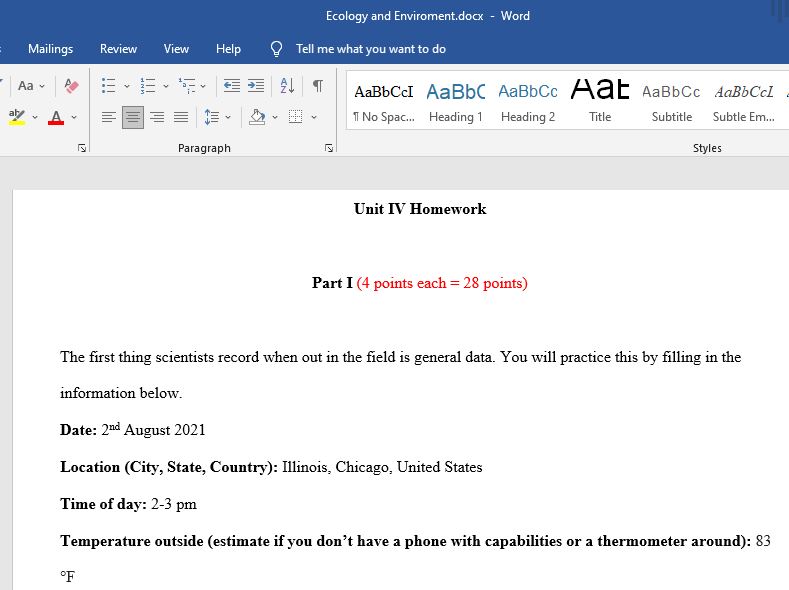Ecology and Environment Homework
This activity can be completed in your backyard, in your office yard, a nearby park, an urban green space, or
anywhere you can get a little bit of nature under your feet!
Now that you have learned about food webs and biodiversity, you will explore the environment “in your own
backyard.” It may be easiest to print out this sheet and take it with you to complete the assignment. You can
always record your answers on a separate piece of paper while outside and then bring them back to your
computer to type in your responses afterward.
Scientists are trained to take very detailed notes when they head out into the field. This is because all of the
information you can collect could be important to analyzing your data in the future. It is important to be
descriptive and even use drawings if you need to make sure your data is as complete as possible.
Part I (4 points each = 28 points)
The first thing scientists record when out in the field is general data. You will practice this by filling in the
information below.
Date:
Location (City, State, Country):
Time of day:
Temperature outside (estimate if you don’t have a phone with capabilities or a thermometer around):
Weather (e.g., rainy, humid, dry, cloudy, sunny, overcast):
Number of people around:
Describe the space/habitat (Is it a prairie? Does it have tall grasses, are there a lot of trees, or is it near
water or a city?):
Part II (20 points)
Now, let’s do some exploring and observing. Sit down on the soil, and take a closer look. Do you see small
insects? Do you notice different types of grasses, weeds, and small flowers?
Take a few minutes to identify everything you can in the area. (Set a maximum time to about 15 minutes).
Record what you find in the table below, and remember to be as descriptive as possible.
In the section “Label of what you found,” identify as best you can what it is you are looking at. Is it a plant
(grass, weed, tree, flower), reptile, amphibian, insect, arachnid (spider), mammal, or bird? Do you know what
species it is? You can use resources to help you identify what you find. If you are in the United States,
download the iNaturalist app, and you can use field guides on the app to help identify what you see. If you are
at a park, at the visitor center, there may be field guide pamphlets or online pamphlets to help with
identifications. You can also try finding field guides for your area online. (Type the following terms into
Google: “field guide to plants, butterflies, or whatever you’re looking at in [insert the place you are]”). Be as
specific as possible.
In the description column, describe what it is. How tall is it? What distinguishing features does it have? Does it
have a scent? Does it have a color?
In the last column, count how many of that species you see in the area.
You are filling in the table with what you find. Your grade is based on the quality of filling in the details of the
table (label, description, and how many found). You will need to include at least five species.
Answer preview:

